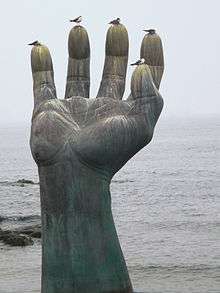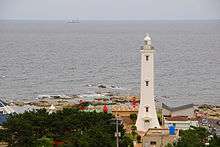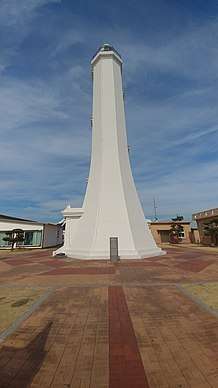Homigot
Homigot (Korean: 호미곶) is a point of land jutting out into the East Sea, is located to the east of urban Pohang in Daebo-myeon. Homigot means "tiger's tail cape." The shape of the Korean Peninsula is often compared to a tiger. Homigot is located on a cape equivalent to the tail of a tiger, so it was designated Homigot.

Geography
Homigot is one of the easternmost points on the Korean peninsula and as such serves every year as a gathering place for thousands to greet Korea's first sunrise of the New Year. The beach is also home to the Hands of Harmony sculpture. The shore of Homigot, which is the tip of Pohang's Yeongil Bay, is a place where the cold currents and warm currents intersect. Accordingly, fixed shore net fishing is active and there are plenty of fish resources such as squid and mackerel pike. Also, the sea breeze is so strong that it is the first test run in North Gyeongsang Province to build a wind generator in 2001.[1] Homigot is a gentle hill mountainous terrain that protrudes three sides into the sea except for the southern part, which is densely populated with five to six peaks at altitudes between 120 and 180 meters above sea level. Pohang Airport, the existing road network linking national roads and provincial roads, as well as nearby port of Guryongpo and Daebo is secured, making it easy to construct wind farms without additional infrastructure investment.[2]
Natural Environment
An analysis of ground weather from 1993 to 2001 at the automatic weather station at Homigot's northern tip showed a distinct difference between summer and winter of wind speed. Starting in October, the wind speed slowly increased, reaching its peak in December and January, and gradually decreasing until July. The average wind speed of more than 5 m/s was measured from December to March, but the average wind speed was below 4 m/s from May to August. In other words, wind speeds tend to remain strong at night in winter and fall during daytime. On the other hand, the wind speed increases in the spring and summer between 3-4 p.m., and the wind speed is maintained almost constant in autumn. Therefore, it is considered that the energy generated by wind power will be concentrated in the winter night time.[3]
History
Joseon Dynasty
During the Myeongjong of Joseon Dynasty in the 16th century, Homigot was explained in 'A secret view of the mountains and water(山水秘境)'by feng shui geomanologist Namsago. In the book, he explained that Homigot corresponds to the tiger's tail. Gim Jeong-ho made Daedongyeojido and measured Homigot seven times to confirm that it is the most eastern part of the country. It is also called Janggigot(長鬐串) and Dongeulbaegot(冬乙背串).[4][5] Yukdang Choi Nam-sun chose the sunrise of Homigot as one of the 10 best points to the Joseon Dynasty.[5]
A tale of Yeon Oh-rang and Se O-nyeo
There is a tale about Yeon Oh-rang Se O-nyeo in Homigot. The name of the main character, Yeon Oh-rang, is believed to have been derived from Youngil bay. In the story of Yeon Oh-rang and Se Oh-nyeo of Samguk yusa, the couple moved to Japan to become kings, and Silla, which had lost the sun and moon, gave the silk that Se O-nyeo had woven. Many theories are being expressed regarding the interpretation of the story, as a member of the Talhae of Silla family is being pushed back to the Japanese government by the family of Hyeokgeose of Silla.[6]
Tourism in North Gyeongsang Province
The sunrise history travel zone is a wide area theme tour centered on the sunrise spot in Korea and Silla culture. The project includes Homigot of Pohang. The project aims to improve the sunrise point environment at Homigot.[7]
Traffic
Homigot, which is located along Yeongil Bay, is frequently shipped by large ships carrying steel materials, products from POSCO. and other miscellaneous goods. Also, fishing boats are active. In particular, the seas near Homigot are areas where ships of ports are frequently traversed and traveled.[8]
Festival
The Sunrise Festival
The sunrise festival at Homigot is held every year on January 1. The sunrise festival has variety of programs. Busking and radio DJ zone are available for citizen participation. Also, there are experiences of decorating Korean paper(Hanji), making a kite for lucky. The most famous is the New Year's Tteokguk(Rice cake soup) eating event. When the New Year comes, rice cake soup for 10,000 people is boiled and shared in a large Gamasot. Gamasot is displayed at Homigot.[9]
The Octopus Festival
The Octopus Festival is held every year on April. It has variety programs. The main theme is catching octopus with bare hand and octopus auction.[10]
The camping Festival
The festival was held to promote the city's attractions and entertainment by using camping, which is the center of the recent trend of healing culture. According to Pohang City government the festival is designed to promote regional economic boom, see and enjoy the event ahead of the regular season.[11] Those who participated in the festival were able to experience camping cook contest, watching the Russia World Cup game and water gun play etc. About 2,000 tourists participated in the festival.[11]
Lighthouse
The Homigot Lighthouse (Korean: 호미곶등대) is an active lighthouse in Pohang, South Korea. With a height of 26.4 metres (87 ft), it is the tallest in South Korea.[12] The lighthouse was built in 1900s, made with only bricks not using rebar. It is shaped like an occipital shape and to ensure the stability of the lower part, the lower part was held wider and narrower as it gradually rose.
National Lighthouse Museum
Korea National Lighthouse Museum is placed in Homigot, right beside Homigot Lighthouse. There is information about all the Lighthouse in Korea.
There is 5 themes in the museum.
- Information retrieval section : Introduction of the relics & exhibition informations using the info-search
- Aids to Navigation History Hall : Introduction of history of aids to navigation in Korea and the world
- Aids to Navigation Relics Hall : Display of visual, sound, radio aids to navigation
- Lighthouse Keepers Hall : Display of the miniature and relics showing the past and present life of lighthouse keepers
- Lighthouse Archive Hall : Various documents related with the history of lighthouse
Hand of Coexistence
'Hand of Coexistence' was made by a professor Seung-guk Kim at Yeongnam University with the support of Pohang Construction and Daegu Bank. In commemoration of the new millennium, 'Hand of Coexistence' is a two-handed sculpture set up at Homigot in Pohang in December 1999. The right hand, 8.5 meters high in the sea, and 5.5 meters high in the sunrise plaza.[13]
Gallery
 Hand of Coexistence
Hand of Coexistence Homigot Lighthouse
Homigot Lighthouse New Millennium Memorial Hall
New Millennium Memorial Hall_-_panoramio.jpg) Homigot Park
Homigot Park
See also
- Homigot Lighthouse
- Yeongil bay (영일만)
- New Millennium memorial hall (새천년기념관)
- Pohang
References
| Wikimedia Commons has media related to Homigot. |
- "소개의글 > 마을안내 > 호미곶알림곶 > 경북포항 호미곶마을" [Introduction> Town Information> Homi Cape Grove Cape> Homi Cape Town, Pohang, Gyeongbuk]. homigot.invil.org (in Korean). Retrieved 2018-04-13.
- "풍력발전 단지조성을 위한 바람환경 분석" [Analysis of Wind Environments for Siting a Wind Farm]. 한국대기환경학회지 / Journal of Korean Society for Atmospheric Environment. 한국대기환경학회 / Korean Society for Atmospheric Environment. 19 (6): 746. 2003.
- "풍력발전 단지조성을 위한 바람환경 분석" [Analysis of Wind Environments for Siting a Wind Farm]. Journal of Korean Society for Atmospheric Environment. 한국대기환경학회 / Korean Society for Atmospheric Environment. 19 (6): 746–747. 2003.
- "호미곶(虎尾串) - 한국민족문화대백과사전". encykorea.aks.ac.kr (in Korean). Retrieved 2018-04-20.
- "[도시를 읽다](21) 경북 포항 - 굽이굽이 호미곶 둘레길, 걷다보면 절경에 '탄성'…여기 철강도시 맞나요?" (in Korean). Retrieved 2018-05-27.
- Lee, Hyeon-woo (2017-11-18). "연오랑과 세오녀의 고향, 포항" [Yeon Oh-rang and Se Oh-nyeo's Hometown, Pohang]. Asia Economy (in Korean). Retrieved 2018-06-24.
- "[경상매일신문]道관광공사, 해돋이역사기행 사업 활성화 MOU". 경상매일신문. Retrieved 2018-06-07.
- 김, 주형; 이, 윤철 (2016). "국내연안 추천항로의 법적지위에 관한 고찰 - 호미곶 추천항로를 중심으로 -" [A Study on the Legal Status of the Recommendable Route in Korea Around the Recommended Route of Homigot]. 海事法硏究 (in Korean). 한국해사법학회. 28: 13–14. Retrieved 16 May 2018.
- "해맞이축제 > 호미곶축제 > 경북포항 호미곶마을". homigot.invil.org (in Korean). Retrieved 2018-05-25.
- "지역축제 - 호미곶 돌문어 축제 | 문화체육관광부" [Homigot Octopus Festival]. www.mcst.go.kr (in Korean). Retrieved 2018-06-24.
- Choi, Chang-ho (2018-06-22). "포항 호미곶서 22~24일 캠핑 페스티벌 개막…월드컵 응원도" [From 22nd to 24th at Homigot, Pohang, the camping festival opens ... World Cup cheering]. News1 (in Korean). Retrieved 2018-06-24.
- "국립등대박물관 홈페이지".
- "포항 호미곶 '상생의 손', 저작권 다툼" (in Korean). Retrieved 2018-06-03.
External links
- Homigot official site : http://homigot.invil.org/index.html

